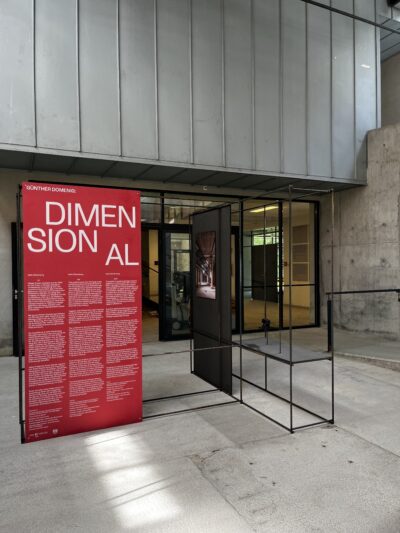About
Günther Domenig
A LIFE OF RESISTANCE
Günther Domenig was born in Klagenfurt in 1934 and spent his childhood in the Mölltal, a narrow valley surrounded by high mountains in Upper Carinthia, where he lived during the Second World War — punctuated by summers spent with his grandmother at Lake Ossiach – until 1946.
It was here that a central motif of his architecture was shaped: the rugged mountain land- scape with its diverse rock formations, which is key to the construction of the Steinhaus – a fusion between organic and inorganic architecture.
Günther Domenig was born into a National Socialist family. His father was a district judge in Klagenfurt and a Nazi. In 1944 he was captured by partisans in Trieste and executed. His mother was also an NSDAP official.
Arguably as a result of this, Günther Domenig developed a resistance that manifested itself on many levels, among other things in his opposition to all architectural conventions of the post-war period, resisting a specific form of use and challenging social norms.
Throughout his life he struggled to come to terms with his origins and became an avowed anti-fascist. He eventually achieved some reconciliation with his own family history in the project for the Documentation Center Nazi Party Rally Grounds in Nuremberg, a stark intervention in a highly charged site.
Intervention and resistance became a convincing unity and “the manifesto of an artistic ethic” (Peter Noever).
Günther Domenig studied architecture at Graz University of Technology from 1953 to 1959. He stayed in the city, working as a freelance architect from 1960 and established his partnership with fellow student Eilfried Huth. For over a decade the two worked in a symbiotic partnership that is reflected in a variety of projects. During this time they produced utopian projects such as the megastructure “Neue Wohnform Ragnitz”, which in 1969 earned them the Grand Prix International d’Urbanisme et d’Architecture in Cannes.
While initially influenced by role models such as Walter Förderer and Gottfried Böhm – both of them exponents of brutalism in Switzerland and Germany, who had in turn been inspired by Le Corbusier’s sculptural exposed concrete buildings – they went on to develop their own architectural language, which, following the zeitgeist of the late 1960s and early 1970s, evolved into the Graz School and so shaped an entire generation of architects.
In 1980, Günther Domenig was made Professor of Housing and Design at the Institute of Design and Building Typology at Graz University of Technology. This was followed by numerous visiting professorships in Austria and abroad.
After the end of his collaboration with Eilfried Huth in 1973, Günther Domenig worked alone on the design for the Z‑Sparkasse in the Favoriten district of Vienna. The building brought him instant fame and at the same time established his reputation as a polarising architect – an attribution that was to accompany him all his life.
Günther Domenig’s work continued to be shaped by collaborative thinking, however, as is reflected in his cooperation with many architects as office partners. Volker Giencke, Hermann Eisenköck, Peter Hellweger, Architektur Consult, and Gerhard Wallner should all be mentioned here. All of his major projects were produced during this time, the last being the T‑Center St. Marx (2000−2004) in Vienna.
Over a period spanning almost thirty years – starting in the 1970s – Günther Domenig worked on his most radical design, the Steinhaus in the village of Steindorf at Lake Ossiach. “With the Steinhaus, he worked relentlessly to create a place of retreat, a unique laboratory. This urban structure stands – ‘like an apocalypse’ – in stark contrast to all the convention surrounding it. Not least due to its character as processual architecture, as a work-in-progress, this house has remained avant-garde to this day. Because of its perpetually unfinished nature, the Steinhaus remains a utopia. Its realization must therefore accept that it will be broken off, which makes his work an allegory of human existence.” (Peter Noever)
Günther Domenig died in Graz in 2012.
AWARDS (SELECTED)
2010 GerambRose of the BauKultur
Steiermark association, Bad Gleichenberg thermal spa complex
2009 Josef Lackner Prize of the Faculty of Architecture at the University of Innsbruck
2006 State Prize for Architecture, T‑Center St. Marx, Vienna
2006 Clients’ Prize of the Central Association of Austrian Architects, T‑Center St. Marx,
Vienna
2004 Grand Austrian State Prize
2004 Otto Wagner Urban Development Prize, T‑Center St. Marx, Vienna
2004 Golden Lion for Transformations, 9th Venice Biennale of Architecture, Documentation Center Nazi Party Rally Grounds Nuremberg
2004 Austrian Decoration for Science and Art 1st class
1996 Honorary Prize of the State of Carinthia 1995 Golden Medal of Honor of the City of Vienna
1975 Prix Europeen de la Construction Metallique 1975
1969 Grand Prix International d’Urbanisme et d’Architecture, Cannes, Neue Wohnform Ragnitz
Objects







